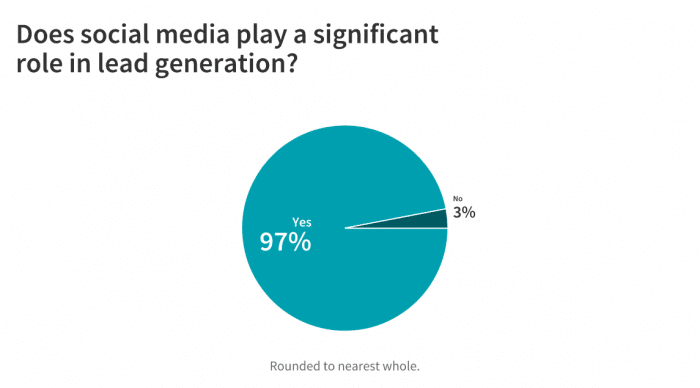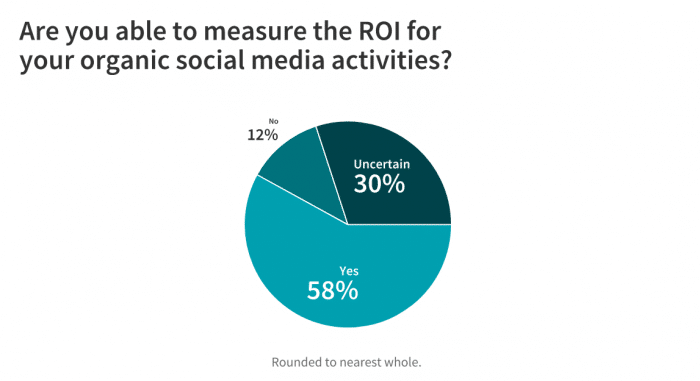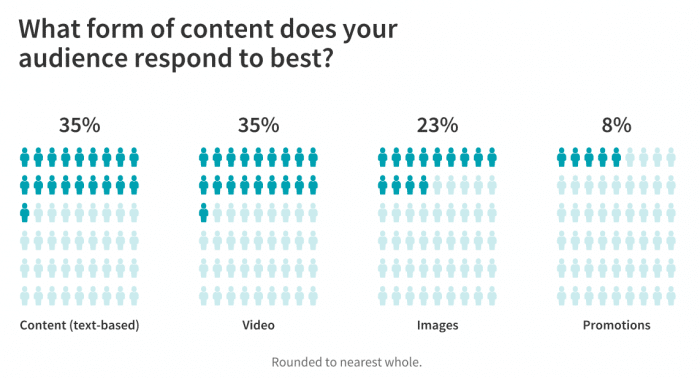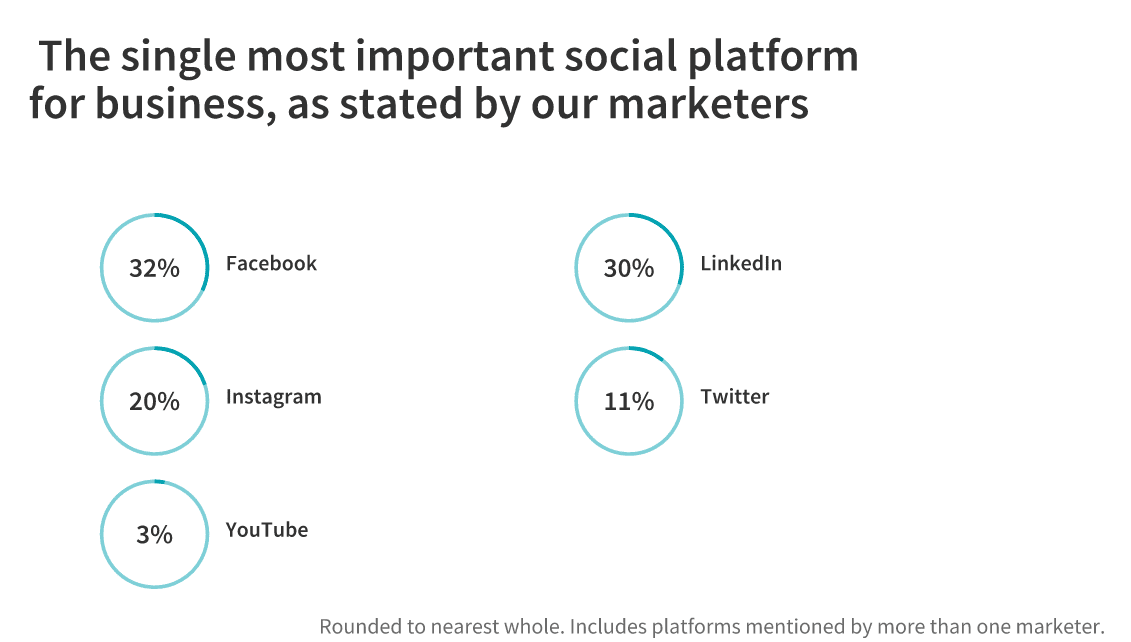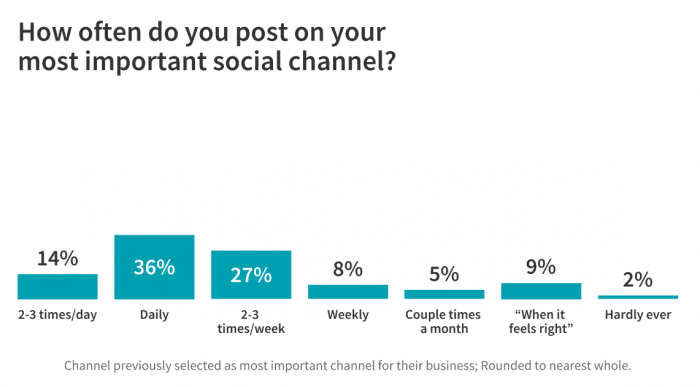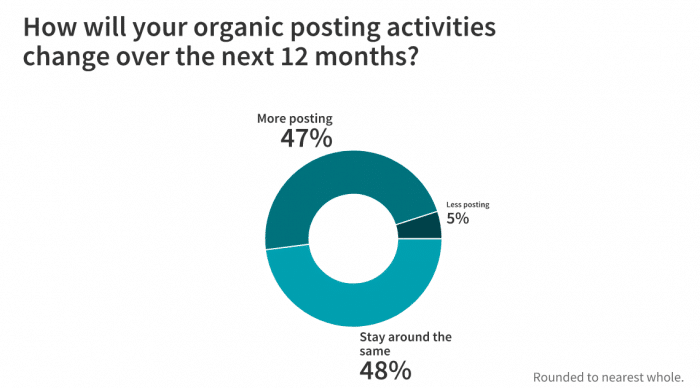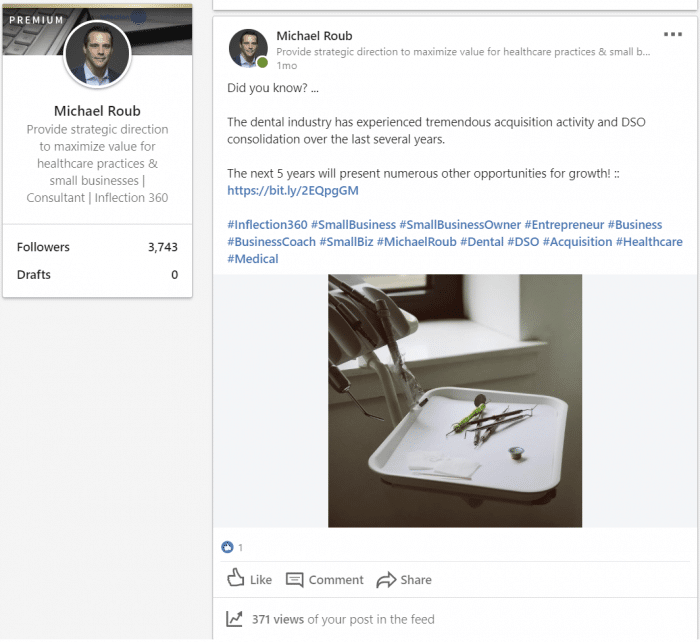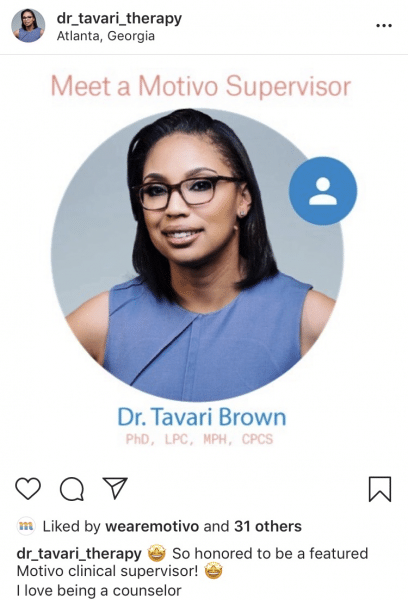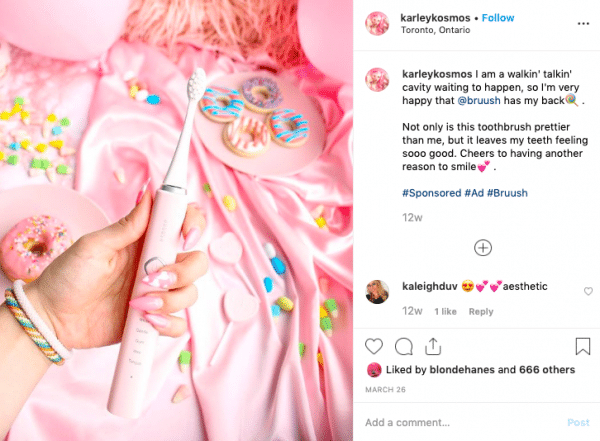Everyone seems to have a profile on at least one social media platform. And for many businesses, this acts as a way to lead them right to their target market. Social media is a powerful tool for generating leads because it lets you meet your audience right where they are.
Social media marketing and social media ads have seem to become a staple in many marketing strategies (across the board for many business types). Because of this, we wanted to learn what social media platforms fare best for other marketers out there.
We also know that measuring the success of social media as a lead generation tool can be difficult, especially with organic social media (any posts that aren’t paid ads). So can figuring out where your social media pages fit best in your marketing funnel. Thus, we wanted to gather tips for measuring ROI, to help other marketers out.
We launched a survey and received insights from 66 marketers. Below, we cover some interesting statistical findings about lead generation, as well as the detailed tips and tricks straight from the experts.
Social media and lead generation make a great team!
When we asked our marketers whether social media plays a significant role in lead generation, an overwhelming 97% answered yes.
However, like any other marketing effort, you need to be able to track the success of your social media marketing. And as our survey shows, it can be difficult for marketers to measure their ROI when it comes to organic social media.
Only 58% of the marketers we surveyed were sure that they could measure their ROI for organic social media activities. 12% said they could not measure ROI, and 30% were uncertain. (If you also struggle with measuring ROI, there are some great lead generation software tools to check out.)
Text-based content is king… but so is video
We asked marketers, “What form of content does your audience respond to best?” Text-based content came out on top…but more surprisingly, it tied with video for that top spot. (Content and video were each selected by 35% of marketers.)
Why is video so key to marketing on social media? It’s probably due to these factors.
- Text-based content is overly common on social media, but engaging, informative videos (i.e., how-tos, video tutorials) are a good addition to the content.
- More and more users have gone mobile, especially when it comes to entertainment. Consumers love watching videos on mobile, so this might be worth tapping into this habit with branded content.
And stats don’t lie. According to MarTech Advisor, “55% of people watch videos online every day, and social media videos generate up to 1200% more shares than texts and images combined.”
Most important social platforms: Facebook, LinkedIn
Next, we asked marketers to select the single most important social platform for their business. Facebook and LinkedIn won out. (32% chose Facebook and 30% chose LinkedIn.) This makes sense because both Facebook and LinkedIn are used by a broader range of audiences, lend themselves to longer-form content, and best accommodate varied content types.
Facebook can communicate a wide range of information, often serving as a secondary website. And LinkedIn helps marketers develop a professional presence, especially if they’re B2B (here is a great resource on selecting a target audience for LinkedIn Ads).
Other platforms mentioned by more than one marketer included Instagram (20%), Twitter (11%), and YouTube (3%).
Most marketers post frequently, half post daily
We then asked marketers how often they post on their most important social channel (as selected in the previous question), and gave them preset options ranging from 2-3 times a day to “hardly ever.”
- 50% of the marketers reported that they posted at least daily (either once daily or 2-3 times a day).
- Notably, 85% posted at least weekly (with 35% posting at least once a week, but not daily).
- The most popular single option was “daily,” which clocked in at 36%. The second most popular option was “2-3 times a week,” at 27%.
- Only 2% said they post “hardly ever,” and only 6% said they post “when it feels right.”
- Thus, most marketers post to social media frequently, on a set or fairly set schedule.
To follow up, we asked our marketers how they thought their organic posting activities would change over the next 12 months. The vast majority of marketers have either found their balance or have plans to ramp up their posting, which shows that they’ve made organic social a priority. 48% said their posting will stay around the same in the next 12 months, 47% plan to post more, and only 5% plan to post less.
6 tips to discover the ROI of your social media posts
Since measuring ROI on organic social media posts can be a struggle for some, we asked marketers who are successfully measuring their ROI to share how they discover it. Here’s what our marketers had to say.
1. Use URL tracking
To find your ROI on social media, you’ll need to track how much traffic your posts drive to your website—and ideally, how often that traffic converts to a sale. Jerry Haffey Jr. of Ambrosia Treatment Center says, “The metrics provided by social networks are useful within that platform, but it’s challenging to make real-world decisions with that data unless you can calculate your ROI. When we share a piece of content, whether it’s a blog post, an inspirational message, or a video, we use URL tracking. That way, we know the platform where they came from, and we can get a better idea about what is working and what isn’t.”
Sam Laliberte of Brüush advises, “Make campaigns trackable. We value email leads, and organic social has been a great way to drive them. Make sure all your links are being tracked from the source they came from (Instagram bio, swipe up or customized affiliate links) so you know exactly the impact each has had on your funnel.”
UTM tags are a great way to track where your traffic is coming from. Tamara Scott of TechnologyAdvice recommends, “Use UTMs when posting! Set up systems to ensure that your UTMs have consistent formatting across your posts. Then, make saved reports in your Google Analytics (or other analytics tools) early, and update those reports as needed to track the efficacy of your posts.”
Similarly, Alistair Dodds of Ever Increasing Circles says, “We use UTM tags (and bit.ly to shorten them) to track direct traffic from our organic social posts. In Google Analytics, we can then see any sales or leads resulting from said clicks, and, through Google and Facebook attribution modeling, we can also track whether that click later results in a sale via retargeting.”
Gil Resnic of Repsly advises, “Create UTM parameters anytime you link back to a post or piece of content – at Repsly, we make sure to separate out organic social from paid social and add on the channel name as well. We might share the same post organically on LinkedIn as we do in a paid LinkedIn campaign, but with proper UTM parameters, we can easily see which lead came from which post.”
2. Directly ask how customers hear of you
Lauren Patrick of Motivo advocates for asking customers how they first came to know about the company, in addition to using tracking programs. “Whenever we have a new lead come in,” says Patrick, “we ask them, ‘How did you hear about Motivo?’ It’s been great to hear, ‘I saw your Instagram post’ or ‘I heard about you on Twitter.’ Motivo connects pre-licensed therapists with a supervisor to get the hours needed for licensure, and it’s been awesome to discover how active therapists, counselors, and mental health professionals are on social media. On the technical side, we use HubSpot, and the ‘Sources’ report integrates with Google Analytics to show how new contacts converted from social channels. Another tool I’ve used before for marketing attribution is Brightfunnel, which is awesome.”
Similarly, Laura Ferrari of Hyperchat Social shares, “I think the biggest key is to take the time to review the platform metrics and ask your clients how they heard about you and record that information so you can correlate their source and revenue. We use a combination of our CRM, eCommerce, and spreadsheets to help us determine which platforms not only bring in the most leads but the most valuable leads.”
3. Examine customers’ engagement
Engagement, or the likes, comments, and shares a post generates is a key measure of ROI on social media. Says Adrian Dolo of Team 15k, “To discover your estimated ROI, you first have to look at how many people actively interact with your content, and have clicked on links you might’ve posted in the past. Also, the number of people that comment under your post, if not in engagement, can help you determine who is ready to be monetized. It is all about your engagement, that is why it is best not to fake it!”
But the tracking of engagement must be tied to the tracking of conversions. Hilmon Sorey of ClozeLoop recommends that businesses combine engagement tracking with conversion tracking, and see what engagement occurred leading up to the point of each conversion. According to Sorey, businesses should “identify target markets, evaluate post effectiveness, examine reach and engagement, track conversion to conversations, and create ongoing campaigns.” Sorey goes on to say that ClozeLoop’s “goal is to find ways to communicate with our audience thoughtfully, impactfully, and authentically.”
4. Track time and money investments, and compare to goals
According to Cristina Maria of Commusoft, “An easy way [to measure ROI] is to see how many posts per week you need and how long it takes your team to produce these. Then consider their $/hour rate and compare it to your social media goals and how close you are to them. For example, if a 2% increase in social media website traffic referral takes 3 hours of work per week, then this has cost you 3 x $/hour in sheer man-hours spent on the task.
Steve James recommends pairing investment tracking with UTM tags and asking customers where they heard of you: “The time costs and possible advertising costs should be reflected in eventual sales. Ask your customers where they saw your posts, and ensure that any organic posts are directed at your prospect marketplace. Tag each weblink with a suffix so that you can see how many hits your posts get, what type of posts are most popular, and who retains the information.”
5. Use Google’s and Facebook’s tools
The tools built into Google Analytics and Facebook are extremely valuable for ROI tracking. Dustin Radin of Online Visibility, Inc. advises: “Make sure you have Google Analytics set up on your website to track referral traffic from Facebook. Secondly, install the Facebook Pixel on your website and create custom events for specific pages you want to track. You can also create campaign tracking URLs in Google Analytics that will track clicks and conversions from specific buttons or links in your Facebook posts.”
Says Kerri Bugden of Living Online, “Enable custom conversion tracking on lead/sales events through a Facebook Pixel or through LinkedIn’s Insight Tag. This will not only allow you to determine which posts are generating leads, but it will allow you to adjust your social media strategy to maximize your ROI.”
Liz Hughes of Blue Bamboo shares: “Google Analytics is a powerful tool that all website owners should use. It provides data such as how much traffic is visiting your site, and how that traffic behaves once they are there. By adding a Facebook Pixel to your website code, you’ll be able to obtain loads of website data specific to traffic coming from that source.”
6. Multi-pronged methods
Rio Rocket recommends multiple steps and measures for tracking ROI, across different content types: “Accurately measuring your ROI and conversion rates on content is challenging, especially when we’re discussing external content outside of your website. Since you don’t have the benefit of analytics software when marketing content through outside channels, the strategy I have personally developed for both clients and myself is to embed incentivized tracking data into your content marketing CTA.”
“This could be any or all of the following,” says Rocket: “Coupon codes non-identifiable to the customer for discounts or free consultation; links in your marketing content to unique landing pages on your website; more traditional methods such as “Mention Facebook and receive a free gift,” discounts, or consultations, and; unique phone numbers and email addresses used for tracking leads and conversions from your content. From there, your website analytics can then accurately measure content marketing results and ROI. We find that video content usually delivers superior results because almost any tracking method can be seamlessly integrated into the video.”
Sam Rexford of ChillReptile.com recommends careful tracking of organic traffic but also advises turning this unpredictable traffic into traffic your business can control. “You need two things to accurately track, improve, and scale ROI in the funnel with social media traffic,” says Rexford. “First, you need a robust link tracking system and analytics system built into your funnel that has been designed to track and segment campaign data so you can accurately attribute acquisition and sales, find leaks in the funnel, and make improvements. There are many tracking and analytics systems out there like ClickMagick that smart marketers can use to track their efforts throughout the funnel.”
Rexford continues, “Secondly, you need a way to turn your organic traffic into “owned” traffic. Owned traffic means traffic that you control like your email list, bot list, or SMS list. Organic traffic is unpredictable and unreliable when it comes to direct sales and is not controlled by the marketer. A single algorithm update from your social media outlet of choice can wipe out all your efforts overnight. Once you’ve converted visitors into leads on your list, you can nurture and remarket to them and continue to sell to them over months and years and begin to build a predictable source of traffic and sales. Now you’ve got a recipe for tracking, scaling, and predicting revenue growth and ROI from your social media efforts.”
Jamie Walker of reDock advises, “First, determine what is the action that is of value to your company, and determine what you are measuring. This could be the number of people who visited your website, the number of requests or demonstrations, or the number of other forms filled out on your website. After your goal is determined, now you can start to work it back and map the journey.”
Walker also suggests, “Using LinkedIn Sales Navigator, you can easily create lead lists and begin to connect with your target market and engage in meaningful conversations. Keep track of the number of connection requests vs. accepted connections and how many of them complete your ultimate goal.”
Jacob Landis-Eigsti of Jacob LE Video Production shares, “I measure ROI from social media in 3 ways. Firstly, sales directly though the platform. I’ve had a number of conversations from a comment turn into a message on the platform, which later led to a sale. Secondly, I’ll create landing pages that are connected to my social media accounts. I can then track how many people from social media signed up for my email list. Lastly, I keep track of how much traffic to my website is coming from each social media channel.”
Social media’s role in the sales funnel
Finally, we asked marketers how social media fits into their sales funnel or buyer’s journey. Although we received a variety of answers that covered the whole sales funnel, most marketers told us that social media plays a prominent role at the beginning of a potential customer’s journey.
Top of funnel
The vast majority of the marketers we surveyed use social media for the top of their sales funnel – to spread awareness about their brand, generate leads, encourage potential customers to visit their website and view their content, establish authority, and start building relationships with potential customers. Let’s check out how social media fits into their strategies.
Spread awareness
For many businesses, social media is at the very top of the sales funnel, as it’s where potential customers first hear about the company on a more casual level. Marko Saric of How to Make My Blog shares, “Social media for me is more at the awareness and branding stage. Unlike Google and other search engines where users have a clear (and many times commercial) intent, social media is where they are to relax, get news or socialize. So if they do hear about my content and enjoy it, they may get on the mailing list at first or follow me on social. It then takes a few more touchpoints before someone will become a customer or a buyer.”
Jamie Walker of reDock also advocates for raising awareness through social media, as it feels less pushy than other methods. Says Walker, “The old saying ‘be where your audience is’ is even more relevant and far easier today with the help of social media. No matter if your company is B2C or B2B, you are still selling to people, and no one likes to feel they are being sold to. Social media gives you the chance to show them your company benefits and allows them to easily research your company and then (on their own time, with the help from your content) move on to your website where you have more control of their journey. Social media also allows you to segment and truly market to your audience based on their online behavior, and it can also help you identify other markets that you may not have thought of.”
Spreading awareness can also mean targeting your audience’s family, friends, and peers, especially if you’re in the health industry. Says Jerry Haffey Jr. from Ambrosia Treatment Center: “As an addiction treatment center, we provide a service that people need, even though they often don’t want to admit it. Our social media strategy focuses mostly on the top of the funnel. People in the middle and bottom of the funnel have already recognized that they have a problem with drugs and alcohol, and likely they have called us or a competitor in the past. Everyone knows someone who is struggling or has struggled with an addiction or a mental health issue. Usually, loved ones are the bridge to people getting the help that they need. On social, we stick to targeting parents, siblings, grandparents, and friends. Even though they aren’t the actual consumer, they will lead us there.”
When your brand is especially visual or experiential, social media is the perfect way to show off your products and services. Maksym Podsolonko of Magic Day says, “Instagram, in particular, is extremely important for the events industry. It offers the best way to reach new leads through hashtags, cross-mentions, and other actions that put your content in front of a new audience already searching for your services. Visual content shared in an engaging and story-telling way triggers the best engagement in comparison to all other social media platforms.”
And no matter your industry, the visual aspect of social media can help your brand stand out from the crowd. Leo Friedman from iPromo says, “Social media fits in the beginning stages of our buyer’s journey, in the awareness phase. There’s some fierce competition in our industry, and social media is a lever utilized to help us stand out. It’s advantageous as potential buyers become aware of our offerings and are able to visualize them. By creating compelling content, we are able to capture the interest of prospective buyers and tell our story.”
Remember that building relationships with potential customers is vital at every stage, including the awareness stage at the top of the funnel— and social media can be key to starting personalized interactions. Ben Guez of Laxir says: “Facebook and Instagram are heavily trafficked by our consumers, and we use A/B testing to determine how users can be introduced to a sales funnel. We want to start a conversation, a relationship, with our buyers by introducing them to our business through social media, as it is cheaper and more efficient. Marketing has changed from merely selling a product to now interacting with the company and the product together. The communication available within social media creates a more customer-centric sales model.”
Generate leads
As many of the marketers, we surveyed shared, social media is a highly powerful lead generation tool. Laura Gonzalez from Audi South Orlando shares: “Social media fits right at the top of our sales funnel. It’s where we capture leads that are still in the discovery or awareness stage. We advertise on Facebook regularly using the data from Facebook’s Ad Manager to target consumers who are at or near the top of the funnel and fit our demo/psychographic criteria. Our advertising is designed to capture their attention and direct them to an SLP where they can learn more and fill out a form if they wish.”
Says Jack Niederer from Noocaf Coffee, “Instagram is by far our strongest initiator into a buyer’s journey. Having an extremely niche product as we do, it’s very important that you have access and influence in the right circles. Instagram is the only place where we can source converting leads effectively in this way. On Instagram, someone is far more likely to engage and take action on a business’ content, and having this content bolstered by peers and members of a community is enough to drive people to the site and to convert.”
Furqan Tafseer of Stratigia generates leads on social media with a customized approach: “We use social media, especially LinkedIn, for lead generation, and it has a crucial role in our attract and engage parts of the sales funnel. We are a SaaS marketing agency and we work for various B2B SaaS for which this strategy works well.
“The strategy mainly consists of finding the right prospects and connecting with them. In parallel, we try to share educational content (related to the persona we are targeting) on the official page of the brand we are working for. Whenever the prospect engages with us, we try and educate them using the same social media platform and route them towards the company page, rather than the website. And then the next steps of our sales funnel come in. The greatest benefit this strategy provides is excellent personalization, which plays a crucial role.”
Camille Ferland from Client Attract Marketing advocates for combining paid and organic social for lead generation, and reminds other businesses that offering value to their audience is crucial. Says Ferland, “Social media is the starting point of the sales funnels for my clients. We start with a paid Facebook ad that targets the right demographic and leads to a landing page, followed by an email sequence.
“Organic social media is important as well because it helps potential clients be informed about the products and services that the company offers, but organic social media alone is often a tough way of generating new clients for a business. Many people don’t want to follow a company page that posts promotion after promotion without providing value. It is important to provide value, in whatever form is appropriate for your type of business and your audience, which could mean posting educational content, entertaining but relevant content, and the occasional tasteful self-promotional post.”
Dustin Radin of Online Visibility, Inc. also focuses on paid social to generate leads. “We’ve really come to the point of mastering Facebook and Instagram ads for lead generation,” says Radin. “At the moment, Facebook and Instagram ads serve as the primary lead generation source to drive qualified leads into our own internal sales funnel.
“We’ve also used Facebook and Instagram ads to generate thousands of leads for large scale sales operations including call centers. Our Facebook ads first attract the interest of prospects, and depending on their behavior, we retarget them until they become leads that book on our calendar. At that point, a salesperson will meet them on a call and take it from there. We have a well-defined cost per lead and repeatable, scalable process for generating leads on Facebook and Instagram.”
Direct to the company website / Direct to content
Often, social media’s role in lead generation involves directing audiences to your company website, where you can more closely monitor their journey. Used in this way, many consider social media to be a pre-funnel stage rather than being within the top of the funnel.
Shaan Patel of PrepExpert shares, “Social media fits into our strategy by acting as the opening of our primary content marketing funnel. By using targeted Facebook, Snap, and Quora ads, we are able to feed prospective customers into our automated webinar funnel. This funnel is comprised of my main presentation webinar, followed by a re-engagement email drip campaign for non-attendees and coupon email follow up for those that do attend. By utilizing Facebook’s targeting algorithms, we can zero in on exactly the demographics best suited for the services we provide.”
Says Ollie Smith from Expertsure: “We primarily use our social media presence to direct traffic to our website, bringing them into the sales funnel at that point through the use of a contact form. We focus on educating our target audience through the production and dissemination of value-adding content, in the form of blog posts, articles, and infographics. If our target audience sees us as a credible and trustworthy source, they will advance into the funnel, and in turn, we will achieve our social media related objectives.”
Cristina Maria of Commusoft tells us, “We use social media to direct people to top-funnel content like articles, then use the article to direct them to mid-funnel gated content. It’s an easy strategy, but it paid off with a large email database of qualified leads who actively follow our content. Not to mention the branding advantages we gain when we create a cohesive voice by interacting in-real-time with our followers.”
Establish authority and inform
Social media can also be a way to offer your audience valuable information that they’ve been searching for, and show your brand’s expertise. Laura Ferrari of Hyperchat Social knows how to leverage education to generate leads on social media: “As a social media marketing agency, we use our own social media to generate leads and nurture them by being a resource for marketing tips. Our followers tend to be looking through our social for ideas they can implement in their business. We strategically link back to our website in our social content to drive leads through to our funnel.”
Hilmon Sorey of ClozeLoop says, “Social is at the top of our funnel. We produce a lot of content and distribute it freely. Our goal is to inform a large population of the sales by offering relevant content which increases individual and team performance. A subset of that population finds that they would benefit from a more cohesive or customized engagement, and they opt into our process for evaluating how we can partner.”
Eckhard Ortwein of Lean Case uses careful LinkedIn interactions to establish brand authority. Says Ortwein, “One of my key audiences are investors, and they are people who are hard to reach. They know a lot, and you can’t attract them with educational how-to content on your site.
“I join LinkedIn groups my prospects are in and use a consistent mix of actions to be an active, helpful, and valuable community member – help the community by answering questions, post other people’s content that I liked, comment on other members’ posts with my thoughts, and post useful information on how using my product makes it easier to work with an investment portfolio. There are no direct call-to-actions in the content that actually promotes my product, and I don’t send them any cold emails. But my prospects eventually turn to me to get advice when they see that my product is really useful for them.”
Rob Stand of Seobetter uses a similar approach but establishes authority with compelling videos. “We run courses to help people with things such as Amazon selling, setting up a dropshipping website and SEO,” says Stand.
“I use YouTube to release some free ‘how to’ guided videos on topics related to our courses or blog posts. From here, while also running an Adwords display campaign, we can re-target people who have viewed our videos on YouTube through our Adwords campaign. This is an amazing form of re-targeting as it provides a higher ROI. As our courses are video tutorials, it allows us to gain quicker traction with converting new students.”
Middle of funnel
Despite its popularity as a top-of-funnel tool, social media also has its place in the middle and at the bottom of the funnel, as some of the marketers shared. A few marketers told us about how they use social media for lead nurturing, in the middle of the sales funnel.
James Pollard of The Advisor Coach, says: “I’ve found that social media is a great nurturing tool. If someone is on the fence about using a particular product or service, observing your post on social media for a few weeks is a great way for them to get comfortable with you. Plus, they have the opportunity to engage and ask relevant questions. Also, social media is a great way to build social proof. If other people are engaging with you and talking about how great your services are, it makes a prospect more likely to take action.”
Ross Palmer of Lab Society shares how Instagram helps Lab Society build relationships with interested leads: “In many ways, our business was built on Instagram. In our experience, Instagram has been the most direct way to reach engaged potential buyers. Through direct messaging and content marketing, we’ve been able to reach a large portion of our target market, and it remains one of the best ways to find and reach potential new buyers.”
Michael Roub of Inflection 360 establishes authority through social media, but uses this authority to nurture existing leads rather than just to capture their attention. “My business, Inflection 360, is focused on consulting to healthcare practices. When I reach out to prospective clients, it is enormously beneficial to have content on LinkedIn and other social media that reinforces my expertise in their industry,” says Roub.
“It is critical that a post resonates with a prospective client to allow for that first call or meeting to explore opportunities together. While social media across platforms is important just for awareness and exposure, the content specifically used on LinkedIn has been instrumental in landing clients and developing relationships with others working in the healthcare space – lawyers, accountants, etc. – who also have the ability to introduce clients.”
An example of a post Roub used to establish authority and resonate specifically with dental practices.
Bottom of funnel
The bottom of the funnel is a far less popular place for using social media, but Tom Feltham of Software Path has found it to be a great way to engage with high-value leads. “We use social media at the bottom of our sales funnel to engage with key accounts and contacts that our sales and demand generation teams have identified as high value,” says Feltham. “This provides direct communication access to those contacts that may not be reachable by email or phone. This can be as simple as engaging with a company account’s posts or more conversational engagement with an employee’s account.”
Customer advocacy
Several marketers use social media to promote customer advocacy and harness the power of word-of-mouth. This is a unique “stage” as it actually covers two distinct stages in the buyer’s journey—before the sale for a lead, and after the sale for the advocate. It taps into established customers’ recommendations to capture new leads and provide early nurturing to these leads. Potential customers rely on reviews and recommendations from experienced customers, so never discount the advocacy stage!
Jacob Dayan of Community Tax tells us, “We use social media to optimize the ‘Advocacy’ stage of our buyer’s journey. The first thing that many potential customers look at when researching a company is its reviews, and social media is an excellent way to highlight positive ones. User-generated content like reviews help make the experience more authentic and help make your brand image more trustworthy.”
Lauren Patrick of Motivo shares, “Social media is essential for the top of the funnel and brand awareness. On the flipside of the buyer’s journey, during customer adoption, Motivo profiles our customers for case studies and ‘Supervisor Spotlights,’ tagging our customers on social media when we share their content. It’s a great way to make our customers our advocates (or ‘Motivators’ at Motivo) to help with word-of-mouth marketing.”
An example of a Motivo Supervisor Spotlight (reposted by the supervisor). Courtesy of Patrick.
Says Scott Crumrine from Guava Family: “Social media is an integral part of our buyer’s journey as it acts as a virtual and highly visible worth of mouth marketing platform for our brand. By engaging with our community online and showcasing customer reviews, we’re able to pique the interest of prospective buyers. Buyers can interact with our accounts, ask questions, and experience organic testimonials of how our products help make families’ lives a bit easier.”
Sam Laliberte of Brüush knows how to use user-generated content and partnerships with influencers (other awesome word-of-mouth tools) to generate and nurture leads through trust. “If you have a look at the Brüush Instagram account,” says Laliberte, “you’ll currently see less than 40 posted photos yet more than 100 tagged photos from other accounts. When we launched our direct-to-consumer, premium electric toothbrush subscription in November 2018, we knew that social media would be a primary channel for raising brand awareness in time for holiday shopping, but that the messaging couldn’t come solely from us.
To capture last-minute shoppers, we relied on awareness through strategic partnerships with social media influencers which built the top of our sales funnel. Once consumers heard about us from someone they trusted, they were happy to sign up for email updates or follow our brand account where we feed them owned content to further their journey through our funnel to purchase.”
An example of a Brüush sponsored post from a social media influencer, courtesy of Laliberte.
Multiple stages
Don’t think you have to limit social media to one stage of the buyer’s journey. Many marketers have optimized its use throughout the funnel, from the awareness stage to the point of purchase (and after!)
Kerri Bugden of Living Online shares how social media plays a role at the top, in the middle, and at the bottom of her company’s funnel: “We use social media to engage with users at every point in the sales funnel. We tailor our messaging and content to connect with what people are interested in and what their level of knowledge is of our industry.
At the top of the funnel, our objective is to generate awareness and interest. We use a conversational tone and post about topics that relate to our business but that our target audience has a moderate understanding of.
We target users in the middle of the funnel by highlighting their need for professional services and by providing valuable information on how their business could be performing.
For users at the bottom of the funnel, we create detailed and informative posts that offer value to that user and include our brand’s unique selling propositions with a strong CTA.”
Alistair Dodds from Ever Increasing Circles shares: “Social is an essential part of our sales funnel. We use Facebook Business Manager to target cold (top-of-funnel) interest and lookalike custom audiences on Facebook and Instagram. We curate content of interest to this audience and then introduce more of our own content and offers as we move the audience to middle-of-funnel and bottom-of-funnel stages. Social retargeting is key to this, and we use sequential retargeting to build the brand/product story so the audience always sees unique and personalized content appropriate to their place in the sales funnel. Social is storytelling, and there really is no better sales tool than that!”
James Parnwell of TheOnlineCo says: “At the top of the sales funnel, you have cold customers, in the middle, you have warm customers and at the bottom, your hot customers. Social media can reach all of those customers with the right approach. Usually for those at the top of the funnel – cold customers – we would use light engagement, interest creation, and videos. Videos often tend to have a bias in the algorithm towards them.
“In the middle section – warm customers- the goal is engagement and education. This means we’re looking for people to read blog articles, subscribe to lead magnets or engage in content. The bottom of the funnel is where we want to contact. You can do all of this on social media.”
Laura Simis of Coalmarch shares,”For us (and for our clients, as well!) – social media is part of the reputation-building process. We have a difficult time attributing ROI to it because it’s rarely a ‘last touch.’ But our strongest leads from other sources (organic, paid, primarily referral) DO look at social media to get a feel for our expertise and our trustworthiness. It is uniquely top of the funnel (helping us share content, generate awareness, promote engagement from current customers that spark awareness in potential ones) AND bottom of the funnel as part of the consideration phase in our customer journey.”
Liz Hughes of Blue Bamboo advises marketers who use social media throughout the sales funnel to use careful CTAs and links, depending on what funnel stage the post is meant for. Says Hughes, “Blue Bamboo uses social media for all parts of the sales funnel. We have a total audience to engage with, so we need to talk to all levels of the buyer process so that no one is being missed, from brand awareness to product information, to sales promotions to really close the deal. The key is to ensure any links through to further information are related to the intent of the social media post. For example, if your post has been designed to drive brand awareness, it’s too early to then point those customers to a form asking for credit card details. Facebook’s Remarketing and Custom Audiences functions are amazing tools if you really want to take your social media up a notch.”
Sam Rexford of ChillReptile.com emphasizes social media’s role in building trust throughout the sales funnel: “As a blogger and direct marketer who helps other companies and entrepreneurs monetize their content and products with sales funnels, social media plays a vital role at all stages of my personal brand and funnel from acquisition to transaction.
“I actively use social media to attract new leads into my funnel, build trust by adding consistent value and leverage social proof to convert more leads into customers and clients. We now live in an “attention economy,” where one of the most valuable forms of currency is attention, which translates into influence and leverage. The more people that know, like, and trust your brand, and the more attention you can generate, the more leverage your company or brand has to influence sales and revenue.”
Colton De Vos of Resolute Technology Solutions names informing leads, building relationships, and sparking engagement to follow up on as key roles of social media throughout the funnel. Says De Vos, “At Resolute, we use social media to reach people at various stages of the buyer’s journey. We share new content on LinkedIn, Twitter, Facebook, and other channels to answer questions like: ‘What is this technology?’
“How can our business use this technology?’ and ‘What can I expect to pay for this technology?’ Social media also helps us connect with our existing clients by showing them what new projects we’re working on, quotes and photos from staff to give a better sense of our culture, and snapshots from community events we support. Social media helps us build and nurture relationships. When engagement spikes on these posts and it makes sense, we make a note to follow up with the client or prospect. If there are any opportunities, they’re entered into the sales process.”
Jacob Landis-Eigsti from Jacob LE Video Production names driving traffic to his website, starting conversations, and retargeting through paid social as vital roles of social media: “Social media fits into my sales funnel in three ways,” says Landis-Eigsti. “First, social media helps me drive traffic to my website and my email list sign up form. Second, I’ve done some sales and business directly through social media. Leaving comments and engaging with users can start conversations which can turn into a direct message or a phone call.
“Third, I run ads on Facebook, Instagram, and Google Adwords targeted at people who have already visited my website. Retargeting is far more powerful and effective than targeting cold leads. I believe spending too much time ‘building awareness’ can be a big waste of time for small businesses. It’s good to have a clear call to action when you post.”
Finally, Lauren Pope of G2 emphasizes social media’s crucial role at all stages of a buyer’s journey, including post-purchase with loyal existing customers. “It promotes both our new efforts to continue bringing the most valuable software reviews and products to our customers, as well as lends visibility to our blog content and user satisfaction,” says Pope. “Social media should be the cornerstone of any marketing strategy because it’s an easy, cost-effective way to engage your current customers AND reach new clients. We’re living in the age of things going viral every day and any business not at least trying to do that in order to gain exposure is missing a big opportunity.”
Key takeaways
Ready to ramp up social media’s role in your marketing strategy? Follow these tips, based on the insights our marketers shared:
- Post at least weekly, if not daily.
- Remember that video is just as potent as text-based content; it can help you stand out in a sea of text.
- Track your ROI on social media using URL tracking, Google and Facebook tools, and other methods. Don’t be afraid to ask where your customers heard of you, and keep track of your time and money investments.
- Use social media at all points in the sales funnel, if you wish. It can be a powerful tool for generating and nurturing leads at all stages.
- If you want your social media use to be more focused on a specific funnel stage, go with the top of the funnel – spread awareness, generate leads, direct to content, build relationships, and/or establish authority.
- Tap into your customer advocates! Leads trust reviews and recommendations from existing customers when they decide whether to make a purchase. So, share reviews and testimonials on social media! Consider starting a referral program and leveraging social media, to keep even more recommendations rolling in.

